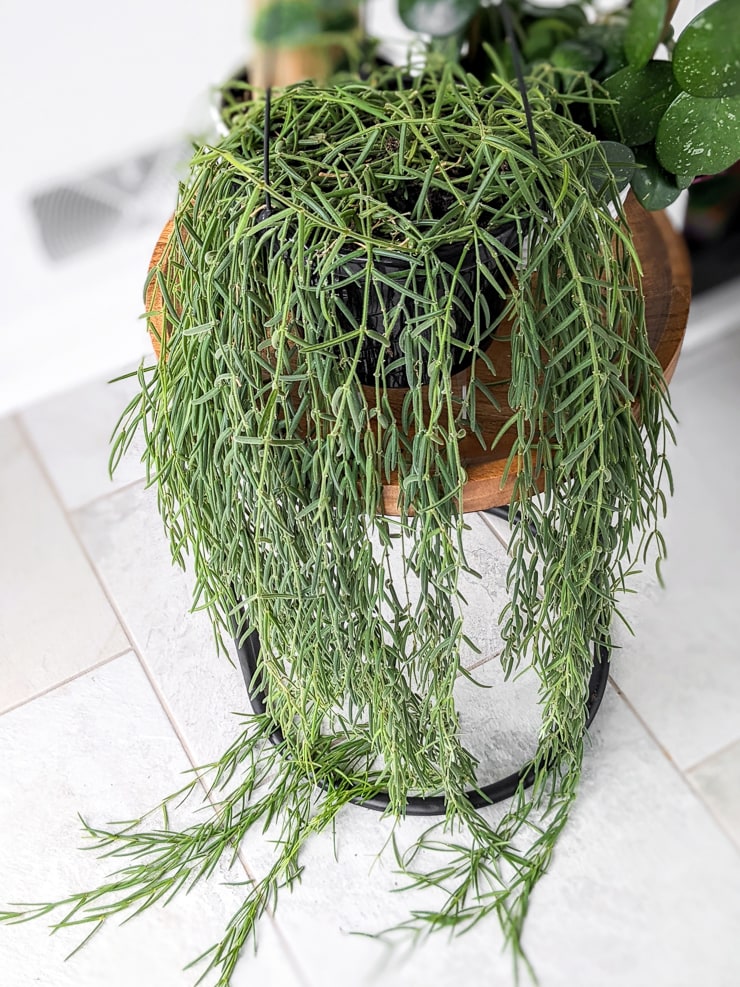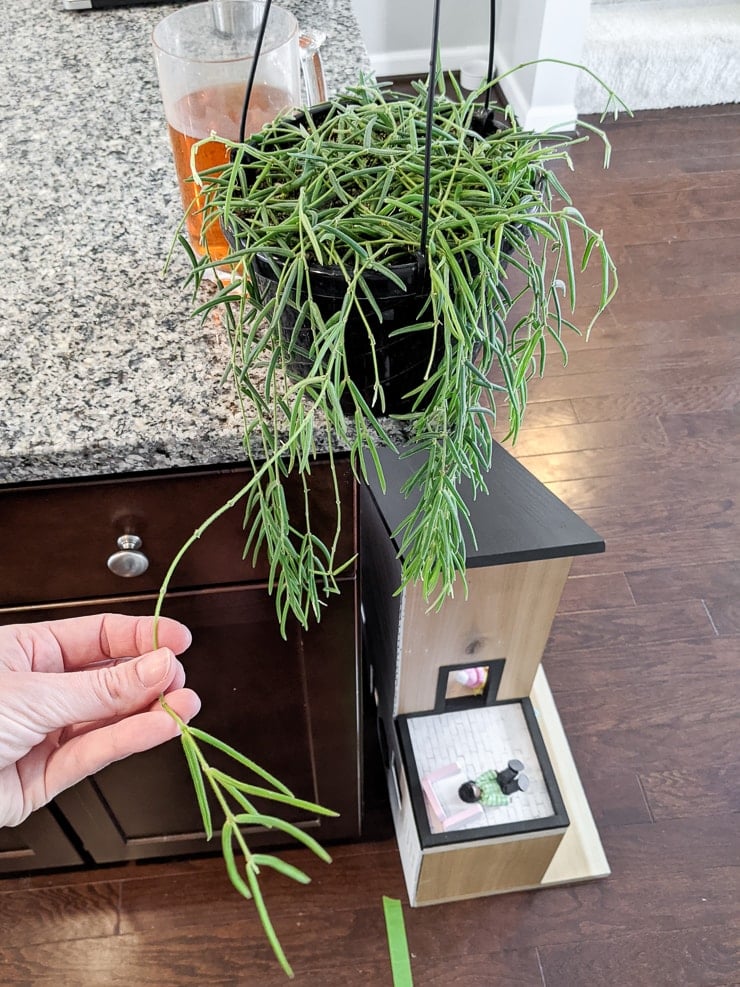How to care for hoya linearis as a houseplant
Today we’re talking about a plant I first got as a cutting…and then got rid of…and then re-bought when I saw a larger plant for sale locally. It’s a hoya linearis! I seem to love hoyas more and more every year.
While the linearis variety is a bit on the trickier side, it isn’t all that hard to care for. It’s a succulent-like, evergreen perennial with long curtain-like stems that drape beautifully when hanging. Rather than large, flat leaves like many other hoyas, its leaves are skinny, soft, and fuzzy. Learn more about its care in my video below—or read on for care tips!

Care overview
- Thrives in bright, indirect light; excessive direct light can burn leaves.
- Plant in a light, airy soil rich in organic matter; water when approximately half of the soil dries out.
- Thrives in 60 to 85°F, preferring high humidity.
- Generally a fast grower under optimal conditions; pruning helps maintain fullness and health.
- Propagate using stem cuttings.
- Non-toxic but is an ornamental plant not meant to be ingested; the sap can be irritating to skin.

Light
The hoya linearis requires bright, indirect light for at least half the day. Direct light will cause the leaves to burn and shrivel and could also lead to the green color fading. It’s also a bit particular about the direction it receives light from. They do appreciate getting light from above, otherwise they could bald a bit around the soil line.
I have had my hoya linearis in four different spots. When we lived at our old house, I first had the plant hanging in my daughter’s bathroom. It had a small west-facing window, but it was generally enough.
Once the plant really started to grow, though, I felt that the growth was getting a bit leggy. So I trimmed it up and moved the plant downstairs to my sunniest location—hanging from a south-facing window that got bright light most of the day. However, some of the light was blocked from the other townhouses around us, so it wasn’t too much light.
At the new house, I was short on space. So I once again hung it in the bathroom. It had a bigger window, but it’s a north-facing window that didn’t get a ton of light. The plant did pretty good. But not great.
And once our sunroom was done, I moved the plant in there. I chose a south-facing window that gets great light. I rotate it every few weeks to ensure that different sides of the plant are exposed to the window. I do have to add a sheer curtain to this window in the summer when the days are long and the sun is intense, but it is otherwise thriving!

Soil
Light and airy soil is best for a hoya linearis. It should be free-draining and rich in organic matter. You can just grab a high-quality indoor or houseplant potting soil from your local nursery. These are usually packed with the good stuff plants like while balancing drainage and lightweight moisture retention.
I actually haven’t repotted the plant below since I purchased it. about 5 years ago. So I can’t say specifically what type of soil I will use for this plant when I do. Right now it is in something that looks heavily peat moss based, so I will probably repot it to my regular houseplant soil mix with a dash of leaf compost.

Water
Hoya linearis have skinny leaves, so they don’t retain as much water as hoya varieties with larger, flat leaves do. They also have weaker roots, which makes watering all the more critical. During its spring and summer growing season, I water it weekly.
Let the soil become saturated, then allow the excess water to drain out the bottom. I generally water the plant in the kitchen sink or bathtub. That way I can thoroughly rinse off the foliage. It would be impossible to clean these small, fragile leaves by hand! Rinsing helps keep things tidy and clean.
In the winter when the plant is dormant, water it lightly only to keep it from drying out. This is usually once every 10-14 days for me. Make sure you are watering the plant in the mornings so excess water evaporates, otherwise it will sit in soggy soil.
Where they are found naturally, it rains heavily. But because they are hanging plants, they get good air circulation and do not sit in water. Overwatering will cause root-rot and damage the plant for sure.

Temperature
Hoya linearis comes from the Himalayan region, which has a very high altitude. This means it gets pretty cold at night. These plants grow best in a 60 to 85 degree Fahrenheit range. As a general rule of thumb, never let the temperature dip below 50 degrees for extended periods of time.
As an indoor plant, though, this shouldn’t be an issue. Just know that it can do fine with some cold snaps at night if you have it outside. It isn’t cold or frost hardy, though.
Humidity
As an epiphyte, this plant loves humidity. Insufficient humidity will cause the plant to wither and the foliage to wilt. You can increase humidity by misting regularly (don’t soak the leaves), keeping it near other plants, or running a humidifier nearby—that’s the best option.
My plant has done quite well in normal household humidity levels, though. I will occasionally mist it or add a humidifier to my sunroom during our dry winters, but I generally do not fuss with it. And my linearis has adapted to the conditions quite well!

Growth
Hoya linearis is generally considered a slow- to moderate-growing plant. However, I have had my large plant for about 5 or so years now. And I feel like it has been a pretty fast-growing plant. When I got it, it had just started trailing—now it’s like 5+ feet long.
It can take several years for it to reach its full size and produce flowers. The growth rate can also depend on the growing conditions such as the amount of light, temperature, humidity and the quality of soil.
Below is an example of my plant’s growth while I’ve had it. The first photo below is not long after I got it. The second was taken about 4 years later. Incredible, isn’t it? And I have pruned it several times over the years! It’s my nature curtain 🙂


Pruning
One of the things I have done routinely while caring for my plant is prune it. These plants can get a bit leggy if left up to their own devices—even in ideal care conditions. The leaves are very fragile, too—they can fall off, leaving bare spots.
So whenever I see those areas on my plant, I cut them off. This then encourages the stem to sprout new growth just above the cut point. This growth branches a bit to the side, which over time helps the plant become lush and bushier. You can also use these cuttings to grow new plants! See below for an example of a stem I snipped off.

Propagation
Propagating a linearis is generally quite simple. The best way is via stem cuttings. Take stem cuttings from a healthy stem that has at least 3 nodes (where the leaf connects to the stem). Remove the leaves except for the top two or three nodes.
Use a rooting hormone to dip the end of the stem cutting, and plant this side down in a soilless mixture made of sphagnum moss and perlite. (For more about rooting plants this way, check out my tutorial about rooting plant cuttings in sphagnum moss.)
Cover the pot with a plastic bag to keep the humidity very high, and water regularly. Make sure you keep the moss mixture evenly moist. If it is too wet, the cutting could rot. Place the pot in indirect, bright light, at a temperature of about 75-80 degrees. Expect roots to grow in 3-4 weeks.




Toxicity
Hoyas are not toxic to pets, but that doesn’t mean you should let your animals chow down on them. Especially because you probably paid a pretty penny for yours. They aren’t meant to be ingested. (See more about pet-safe houseplants!)
While you’re pruning your plant, be warned that this one produces a milky white sap when you cut the stems and leaves. This could irritate your skin, so make sure to wear gardening gloves and wash your hands after working with it.

Want more? Check out my Hoya Krinkle 8 Care Guide, my tips for Hoya Sunrise Care, and my Hoya Krohniana Silver Care & Rooting guide!
Flowering
To get your plant to flower, first it has to be mature. So you may need to give the plant some time. Give it great care—lots of bright, indirect light. I have an article all about How to Get a Hoya to Bloom for more on this topic.
The third year I had my linearis, it produced one or two flowers. Then, in late 2023, I was rinsing off my linearis in the sink when I noticed the start of a new peduncle (where the flower grows from—read more about peduncles here). I looked over the rest of the plant and realized it was absolutely packed with new peduncles sprouting.
Have a look at the pictures below—I truly could not believe it. I can say with certainty that I have not used any special fertilizer. I haven’t even repotted this one with fresh soil in years. I give it the same well-balanced organic plant food I give the rest of my plants in the spring and summer.


Wrapping up…
Hoya linearis is a stunning plant that rewards you with draping growth and lightly scented white flowers. Remember, the key to a thriving linearis is creating the perfect environment and regularly pruning for lush growth.
And in a few years, you might even get those flowers everyone wants! Happy planting, and don’t hesitate to share your own experience with the hoya linearis or ask for advice in the comments below.

Pin my hoya linearis care tips!


Brittany is a seasoned DIY home and garden expert, running a creative brand since 2014 that inspires others with approachable plant care guides, woodworking tutorials, and decor projects. She is a certified project manager and has completed extensive coursework in the art and science of growing your own plants. Her work has been recognized by major publications, and she routinely collaborates with fellow DIY industry leaders—but her favorite thing to do is inspire you! Learn more about her here.

Brittany, I just love your care guide on the Linearis!! I have 3 of these plants one really small and the other two are pretty good sized. I have them under grow lights and near a humidifier. They are doing really well. I love your Linearis’s they are absolutely beautiful!!
Hi Terri, thank you so much! It’s such a lovely plant isn’t it??